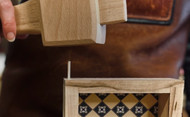Almost everything with woodworking starts with a humble box. This project has similar skills without fitting a lid. A catch all tray provides practice with sawing along your line, marking your layout, keeping parts square, and keeps material costs low so not to break your heart if you need to start over. Learning these basic skills while starting a foundation of having the right tools is a great step forward to feeling empowered in the craft and comfortable with your tools.

Japanese Garden Tools Vs. American: What’s the Difference?
You may have seen Japanese gardening tools popping up more in stores and online. Sure, they’re… Read More


